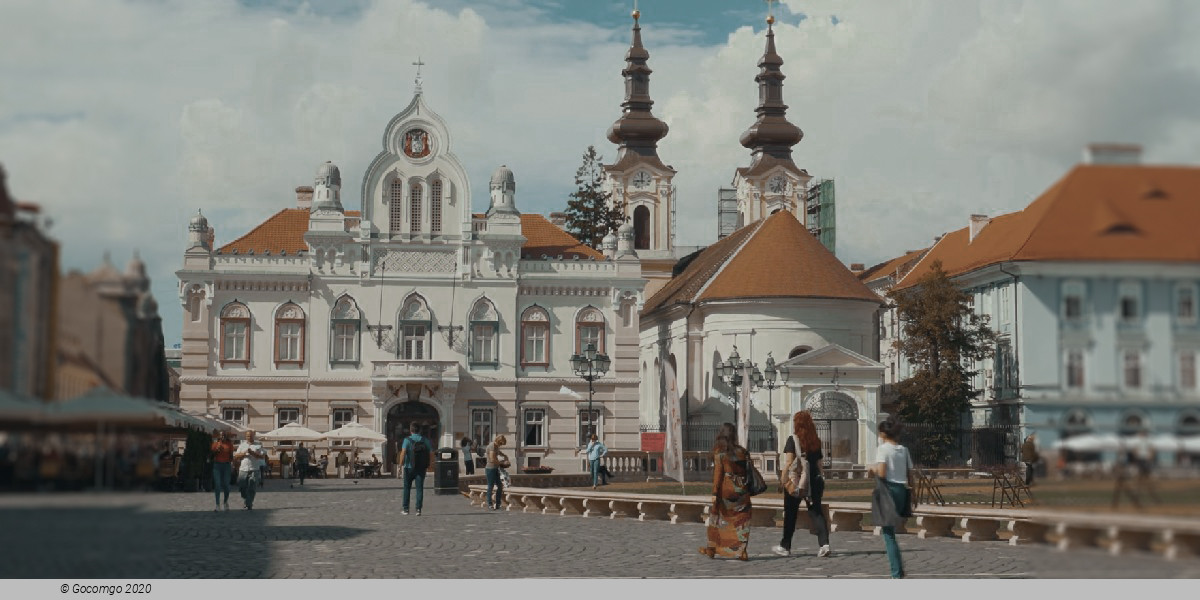Timișoara

Timișoara is the capital city of Timiș County and the main economic, social and cultural center in western Romania. Located on the Bega River, Timișoara is considered the informal capital city of the historical Banat, which is nowadays broadly considered a subregion of Transylvania. From 1848 to 1860 it was the capital of the Serbian Vojvodina and the Voivodeship of Serbia and Banat of Temeschwar.
Nicknamed the "Little Vienna" or the "City of Flowers", Timișoara is noted for its large number of historical monuments and its 36 parks and green spaces. Along with Oradea, Timișoara is part of the Art Nouveau European Route. It is also a member of Eurocities. Timișoara has a very active cultural scene thanks to the city's three state theaters, opera, philharmonic and many other cultural institutions.
Timișoara has the largest architectural ensemble of historic buildings in Romania (around 14,500), consisting of the urban patrimony of the neighborhoods of Cetate, Fabric, Iosefin and Elisabetin. Most of these buildings are part of the imperial heritage, a period of economic prosperity that left its mark on the city. The architectural diversity, represented by baroque, historicism, neoclassicism, Art Nouveau and Wiener Secession, earned Timișoara the nickname "Little Vienna". The oldest building in Timișoara is Huniade Castle, which today houses the Museum of Banat. Destroyed during the siege of 1849, the castle was later rebuilt, but still retains elements of the former castle built by John Hunyadi between 1443 and 1447, but also elements from the period of Charles I of Hungary.
Timișoara is a city with a polynuclear urban structure. The current urban structure, the result of historical evolution, is relatively clear: in the middle of the urban agglomeration is the historic center (Cetate neighborhood) around which the other neighborhoods revolve. Due to their independent development, they have distinct features both functionally and architecturally. The center of today's Timișoara is the "successor" of the Austrian military fortress built mostly between 1732 and 1761. Today, only a few parts of the old city wall remain standing, namely the Theresia Bastion in the east and a few others which are located on the western limit of the old city wall. These were later listed as part of the architectural heritage of Timișoara.
In Timișoara there are eight contemporary art galleries, five of which are publicly-funded: the Pygmalion Gallery (House of Arts), the geamMAT Gallery of the Art Museum, the Helios Gallery (Fine Artists' Union), the Mansarda Gallery (Faculty of Arts and Design) and the City Hall Gallery.
Timișoara is the only city in Europe that has three state theaters in three different languages – the Mihai Eminescu National Theater, the German State Theater and the Gergely Csiky Hungarian State Theater. The three theaters and the National Opera are housed in the Palace of Culture, built between 1871 and 1875 according to the plans of the Viennese architects Ferdinand Fellner and Hermann Helmer, who designed, among others, the Stadttheater in Vienna, the Népszínház in Budapest and the Opera Theater in Odessa. In 2012, the National Theater built and put into operation the Set Factory, the first professional production line of stage props and theater equipment in Romania. Since 2019, the Serbian language theater has been operating within the Merlin Puppet and Youth Theater.
The Romanian National Opera as an institution in its current form has existed since 1947, when the Giuseppe Verdi's opera Aida opened its first season, on 27 April.
Before having a proper musical society, in Timișoara there was the choral association Temeswarer Männergesangverein, founded in 1845. The repertoire of this choir included works of great popularity, belonging mainly to German romantic music. The Philharmonic Society was founded later, in 1871, as a men's choral society. The inaugural concert took place on 8 December and included the ballads Die Frithjof-Saga by Max Bruch and Der Taucher by Heinrich Weidt. Over the years, guest musicians of the Philharmonic Society were invited to perform in Timișoara, among them Franz Liszt, Johann Strauss II, Joseph Haydn, Pablo de Sarasate, Henryk Wieniawski, Johannes Brahms and Béla Bartók. The current Banatul Philharmonic was founded in 1947 by royal decree. The Philharmonic has been organizing the Timișoara Muzicală International Festival since 1968, the longest-running cultural festival in Timișoara.

